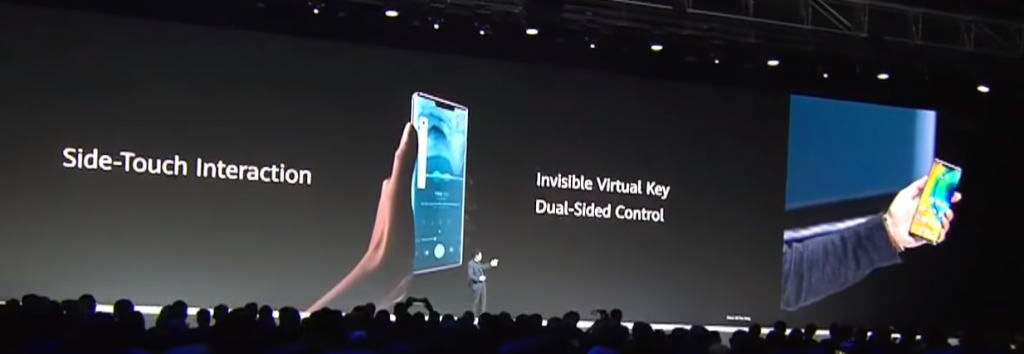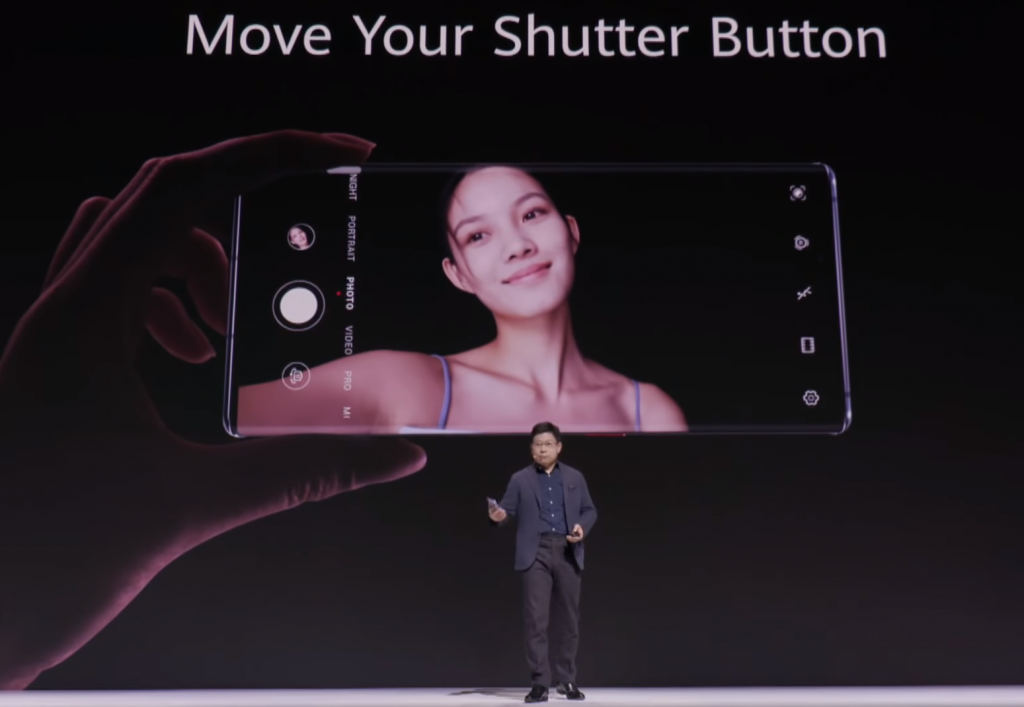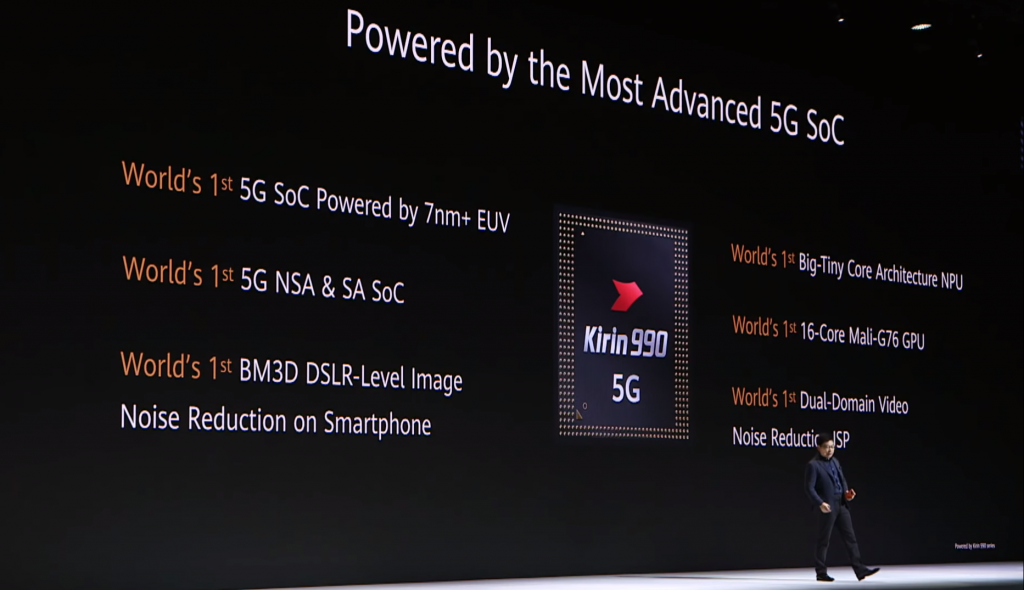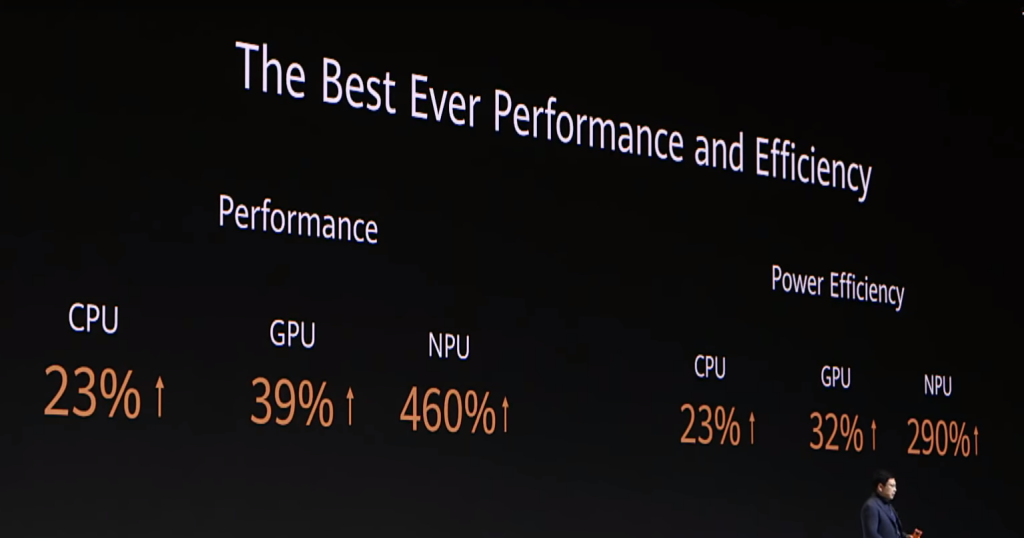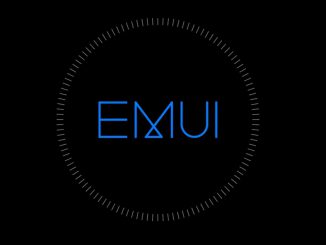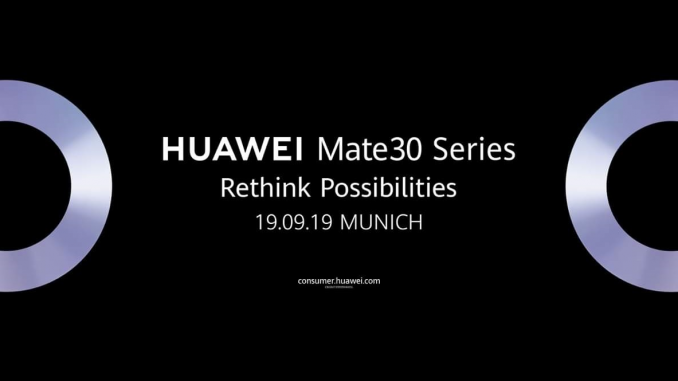
This past 19th of September, directly from Munich, Germany, Huawei introduced the Mate 30 series. This article focuses on the Mate 30 Pro.
Artículo disponible en Español | Article disponible en Français
Richard Yu, CEO of Huawei’s Consumer Business Group, started the introduction of the Mate 30 series with the design of the device, featuring the same industrial look at the top and bottom of the smartphone as introduced with the P30 series:
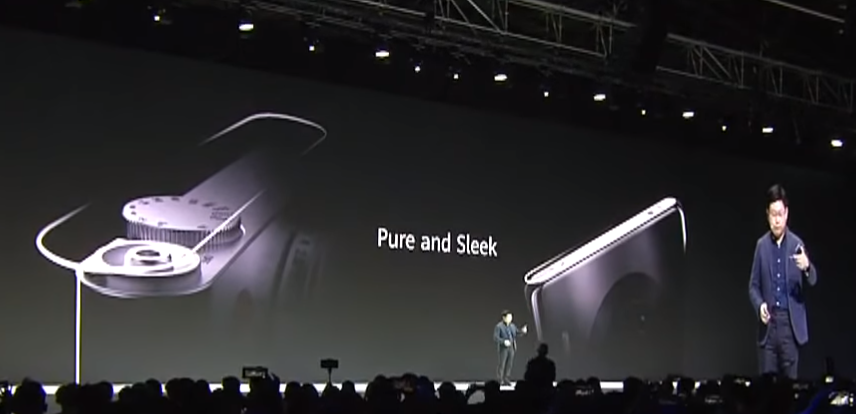
The devices also feature a new rounded camera module, reminding users of a typical professional camera, instead of the square module introduced with the Mate 20 series and now adopted by other brands such as Apple and Google.
On the Mate 30 Pro, the company decided to introduce a new curved display. While past models featured a “FullView” display, and the P30 Pro featured a “DewDrop” display, this time Huawei introduced a “Horizon Display”, having a bigger screen-to-body ratio, at around 94%. The curve of the display is also close to 90º, at 88º, allowing the device to be nearly borderless. Sadly, it would seem Huawei has decided to ignore resolution once again, going back to a 1080p display, just as with the P30 Pro, with the Mate 30 Pro having a resolution of 2400*1176 pixels and a 6.53 inches OLED display. This is a lot less compared to the 1440p on the Mate RS (2880*1440) and the Mate 20 Pro (3120*1440). The Mate 20 Pro was also a rather curious situation, due to the green screen issue on the LG variant, although Mate 20 Pro’s with LG displays had whiter whites, while variants with BOE displays had a more yellowish tint. Obviously, the most likely reason for Huawei to stick to a 1080p resolution is battery life, as 1440p will just consume it too fast. Huawei also claims the displays on the Mate 30 Pro support a new generation of anti-blue light technology, cutting down on blue light emissions by 25%.

Bezels-wise, and as expected with this new curved display, the size has been reduced to 0 millimetres, providing an edge-to-edge display. Meanwhile, the chin is 4.8 millimetres, and the top portion is 4.2 millimetres, all more or less hidden thanks to the metal frame. Weight has gone up too by a few grams, at 198 grams for a device being 158.1×73.1×8.8 millimetres.
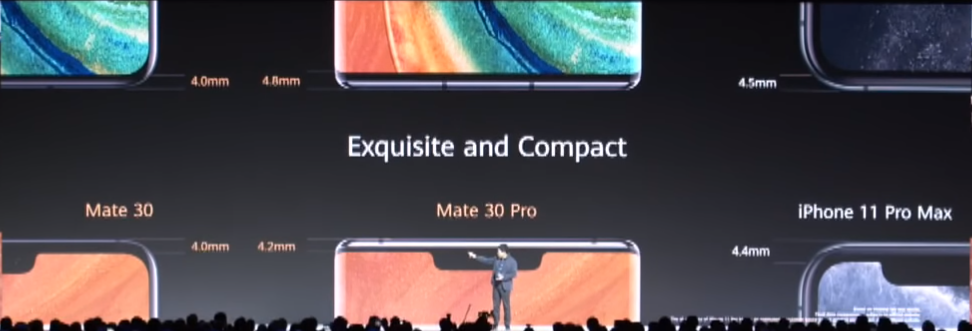
The company has also reduced the size of the notch, moving from 32.8 millimetres on the Mate 20 Pro to 26.6 millimetres on the Mate 30 Pro.
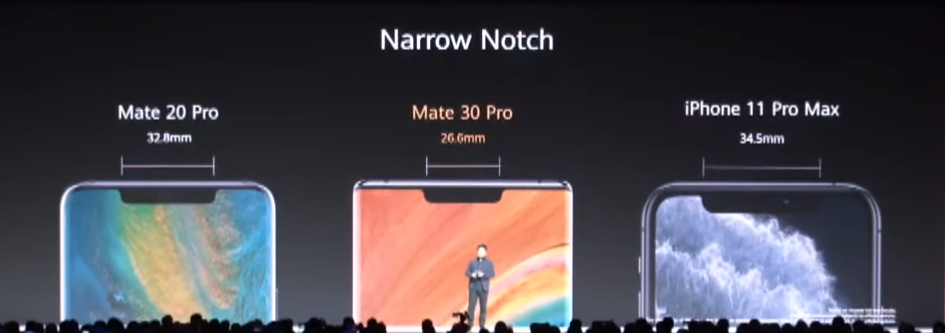
While from the P20 Pro to the P30 Pro, the notch got smaller thanks to the integration of the earpiece to the screen, on the Mate 30 Pro, compared to the Mate 20 Pro, the company has decided to include a few more things, claiming this is the “most sophisticated notch” in the world. This time, they included a gesture sensor, a 3D depth camera, an ambient light and proximity sensor, as well as, obviously, a selfie camera. As we will see later, this new “gesture sensor” introduced by Huawei can do some surprising things, which, depending on the user, will be useful or completely useless. Just as on the P30 Pro, the earpiece is also integrated to the display, using Huawei’s Acoustic Display Technology.

Another new feature introduced with the Mate 30 Pro is the lack of a volume button, only leaving a power button to turn on and off the device. Instead, the device now relies on the sides of the display, which, under normal circumstances, have no real use, but thanks to a few software tweaks, can be used for a few specific situations, such as increasing or decreasing the volume, or provide a custom camera shutter, which is quite interesting, taking in account how often users might be holding the phone in an awkward position to try and take a proper selfie. More surprisingly, the volume option is supported on both sides of the display.
Huawei has also bumped the size of the battery, this time coming with a 4 500mAh battery, instead of a 4 200mAh like on the P30 Pro or the Mate 20 Pro. Charging remains the same, with Huawei’s 40W SuperCharge launched with the Mate 20 Pro, allowing to charge from 0 to 70% in 30 minutes. Meanwhile, wireless charging has been improved once again, this time with the phone receiving 27W. Yes, curiously, Huawei has decided to start calculating the amount of energy received by the device through wireless charging, going as far as claiming their phone supports the fastest wireless charging on the market… for now. This is nothing new for the company, with the Mate RS also having held that title when it launched. The reverse wireless charging has also been improved, being 3 times faster this time around.
The introduction of this faster wireless charging is also an opportunity for the company to release some quite curious charging accessories, which we’ll cover in a different article focusing on the accessories launched alongside the Mate 30 series.
Moving on to the brain of the Mate 30 Pro, the recently announced Kirin 990, this one comes in two different versions: a 5G Kirin 990 and a 4G Kirin 990. We’ve extensively covered the Kirin 990 in a separate article, but, in short, the 5G variant uses a 7nm+ EUV process, while the 4G variant sticks to a 7nm process. The 4G variant is also a bit slower, which is something to keep in mind.
Richard Yu mentioned that while the chip was powerful enough for most tasks, the most important is the power efficiency, which allows the phone to have a longer battery life. This is an argument that is going to start being used regularly, as we get closer to hitting the limit in size reduction on semi-conductors, with foundries now testing 5nm, although this process will initially be very costly to use. With companies reaching the limits in terms of hardware innovation, we see the focus shifting to further optimizing the software, with Huawei claiming a 60% improvement with GPU Turbo on the few supported games, an improvement of 20% on random read performance thanks to EROFS and an improvement in response thanks to a 25% reduction in latency.
The introduction of 5G has also forced manufacturers to adapt the internal layout of their devices, a change that can be particularly observed with the Mate 20 X, with the 5G variant having a smaller battery, going from 5 000mAh down to 4 200mAh, as well as a slightly different mainboard and more antennas overall. This time around, the company claims to have the most advanced 5G antenna design, with 21 antennas in total, 14 of which are 5G. As comparison, Yu mentions that, currently, other manufacturers have up to 6 5G antennas.

The Mate 30 Pro 5G also supports 8 different 5G bands, meaning this device can work with many different networks, instead of models from the competition that are limited to 3 5G bands. Of course, this is mostly due to the expertise of the company in the telecommunications sector. The 5G bands in question are n79, n78, n77, n41, n38, n28, n3 and n1:
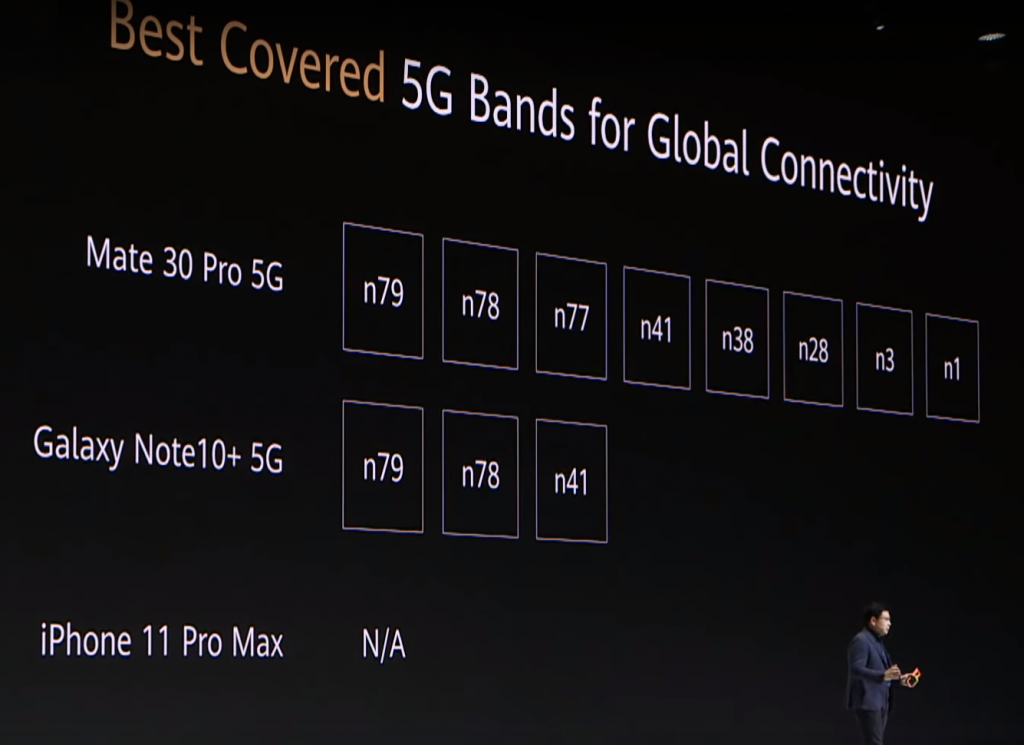
Sadly, one of the current limitations on 5G models is the dual-SIM capability. While users can still enjoy dual-SIM on Huawei’s 5G models, this one only works on one SIM card, meaning a user using dual-SIM will end up with 5G on one SIM and 4G on the second SIM. As with Huawei’s other smartphones, the Mate 30 series also offers the possibility of using a Huawei Nano Memory card to expand the internal storage, with these being sold in 3 different sizes, 64GB, 128GB and 256GB. The manufacturer is also keen on reminding us that the Mate 30 5G and the Mate 30 Pro 5G are the first smartphones with an integrated 5G SoC, supporting both NSA and SA 5G architecture.
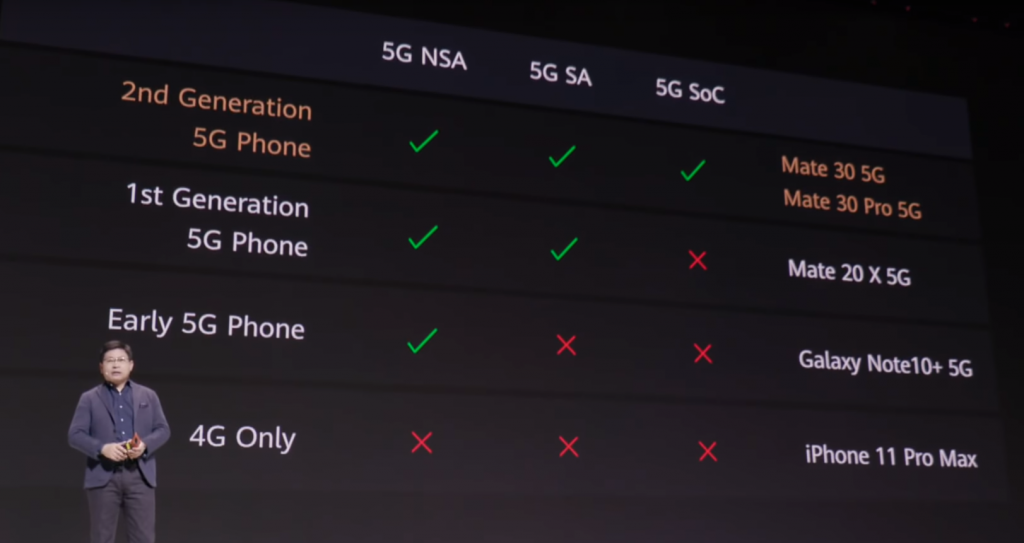
The Mate 30 Pro also comes with a graphene film to improve cooling on the 5G model, as, the hotter the semi-conductors become, the less efficient they are and the more energy they consume. This results in lower battery life and lower performance overall. Huawei claims that thanks to this graphene film, the device is up to 3.9ºC cooler.
After a rather long introduction, the company finally moved on to the camera, which is, as per usual, one of the main selling points of Huawei’s devices. This time, the Mate 30 series introduces a SuperSensing Camera Array which includes 4 different cameras: an ultra-wide cine with a resolution of 40MP, an equivalent focal length of 18mm and an aperture of f/1.8, a SuperSensing wide with 40MP of resolution, an equivalent focal length of 27mm and an aperture of f/1.6, with optical image stabilization, a telephoto camera with a resolution of 8MP and an equivalent focal length of 80mm with an aperture of f/2.4 and optical image stabilization, as well as a 3D depth sensing camera. We also have an ISO of 409 600, 45x zooming range, going from ultra-wide to 3x optical and 30x digital, the possibility of doing professional portraits and dual image stabilization, using both optical and artificial image stabilization:

This time, the manufacturer sticks to the 40MP RYYB sensor used in the P30 series, but combines this one with a 40MP RGGB sensor with a 3:2 ratio, claiming this is more interesting for video recording in general, especially in 4K:
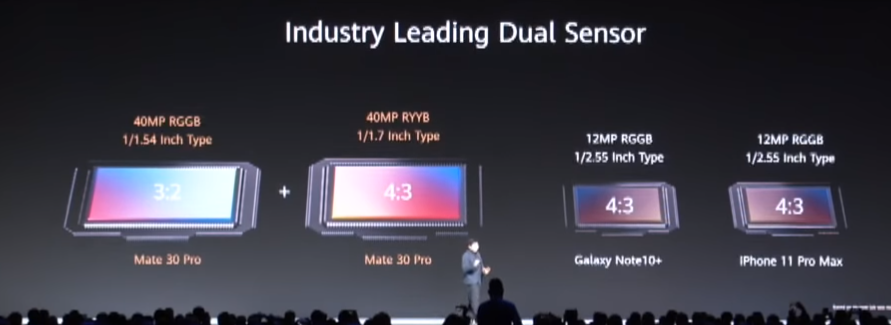
As per usual, Huawei’s Mate 30 Pro is especially good in terms of low-light photography. This time around, the company has also expanded the feature to the ultra-wide-angle lens, an interesting addition to the camera. Zoom-wise, the Mate 30 Pro loses the periscope lens introduced on the P30 Pro, and instead settles for the same solution seen on the P30, allowing users to zoom up to 3 times without losing quality, up to 5 times with an hybrid zoom and a digital zoom of up to 30 times. On the front, we find a 32MP camera, coupled with a 3D depth sensing camera for better selfies.
Huawei’s cameras have always struggled with video. While in most cases, the video output was between fine and good, devices from rival companies would always score better overall. This time, the company intends to resolve this, with the addition of a dedicated 40MP Cine Camera, making the Mate 30 Pro the world’s first smartphone to have this. With this addition, the Mate 30 Pro can record in up to 4K60fps, can record in low-light environments thanks to an ISO of 51 200, offers 4K HDR+ time-lapses capability, real-time Bokeh thanks to the 3D depth sensing camera, and offers stable recording thanks to dual optical and artificial image stabilisation:
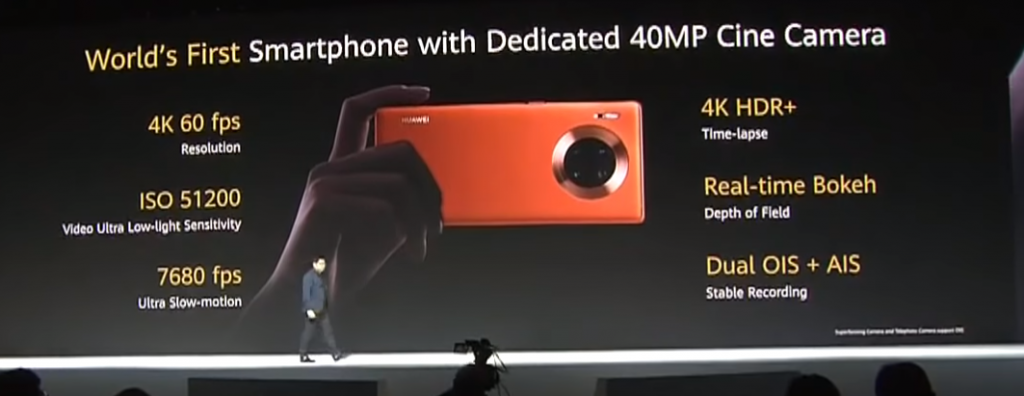
We also see a feature that is available on no other smartphone right now, being ultra-slow motion of up to 7 680 frames per second. To demonstrate the capabilities of their ultra slow-motion, the company showed a video of a hummingbird, claiming these flap their wings up to 80 times per second. With the 7 680 frames per second feature, it is possible to see the wings, and even the tongue of the bird, at least according to the company.
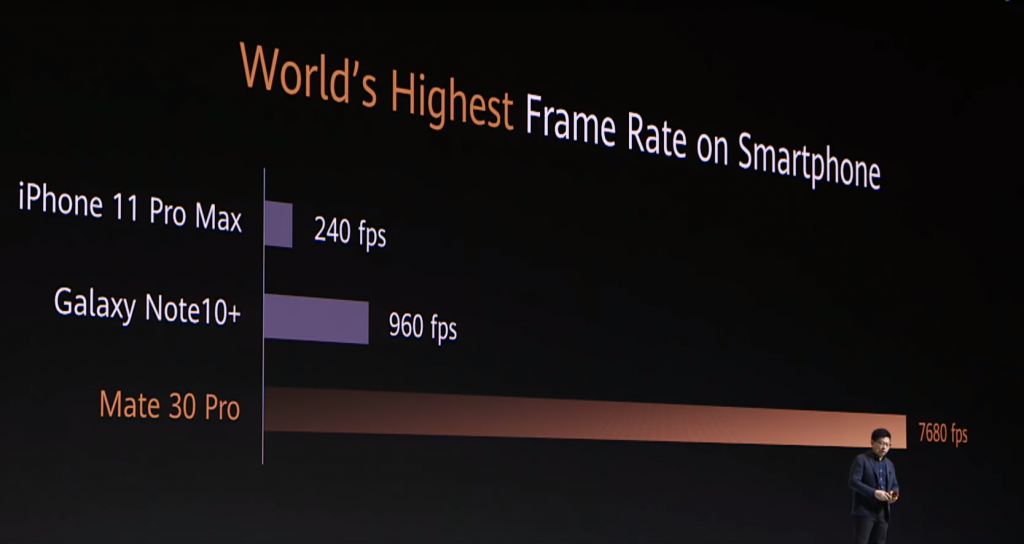
Coming back to the notch of the Mate 30 Pro, this one comes with a camera dedicated for smart gesture controls. With this new functionality, users can use various gestures to navigate, such as swiping to scroll, or grabbing to take a screenshot. Interestingly enough, the company has expanded this functionality, by making it follow the eyes of the users and auto-rotate in the right direction, instead of relying on the usual sensors which are unable to tell whether we are laying down in bed or not. Yes, first world problems, but a nice addition regardless:
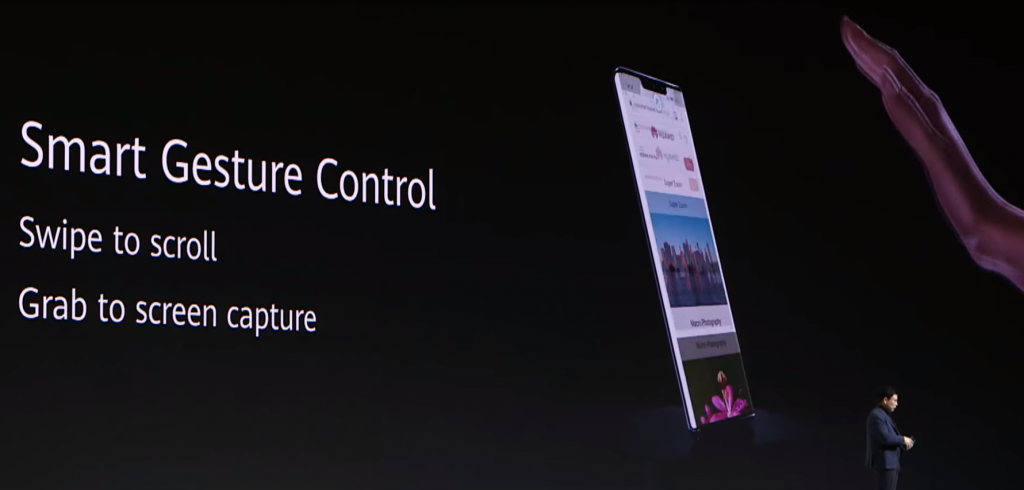
In terms of unlocking the device, the Mate 30 Pro offers the usual options seen on other devices, such as an in-screen fingerprint reader, password or facial recognition. For this one, the company explained how their solution uses the industry’s highest security standard, with a micro kernel OS based on TEE, with this kernel forming part of Huawei’s HarmonyOS kernel, HarmonyOS being the final name of Huawei’s in-house operating system. Huawei also mentions how this kernel is the first one in this world to past the CC EAL 5+ certification, a security evaluation. At the end of the day, for most users, this is just gibberish, and should be understood as, their 3D face unlock is secure.
In terms of pricing, the Huawei Mate 30 Pro, in its 4G, 8GB+256GB variant, will retail for 1 099€.
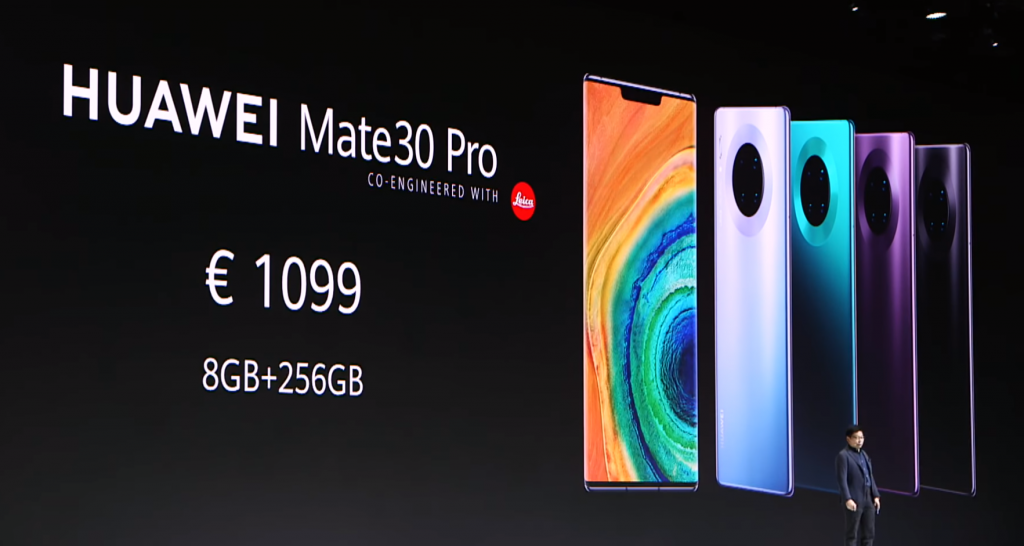
The same specifications but with 5G costs more, at 1 199€.
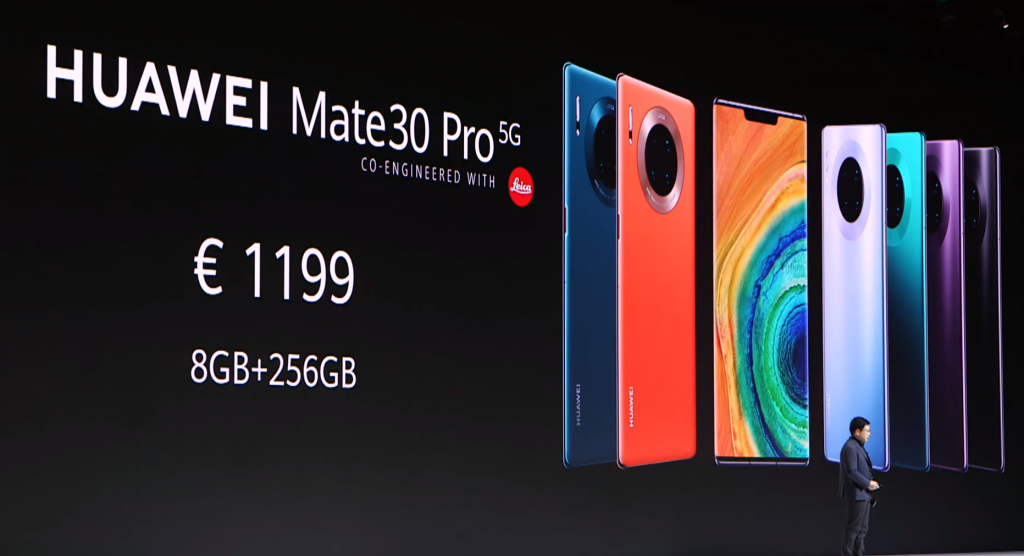
The Mate 30 Pro is available in various colours, including Black, Space Silver, Cosmic Purple and Emerald Green. For the Emerald Green, Huawei says the bottom part of the back has a Matte finish, being fingerprint resistant and non-slippery, making it easier to hold the device, while the top is glossy, making it a gradient. We also see the introduction of 2 leather variants, “Vegan Leather Orange” and “Vegan Leather Forest Green”. This is not the first time Huawei offers devices with leather backs, although these past offerings did not have the explicit mention of “vegan leather” on them. For those wondering, “vegan leather” is not actual leather, it is generally an imitation made out of chemicals, in most cases just being plastic. These two colours are also rated IP68.

In all, the Mate 30 Pro is available in 6 different colours:
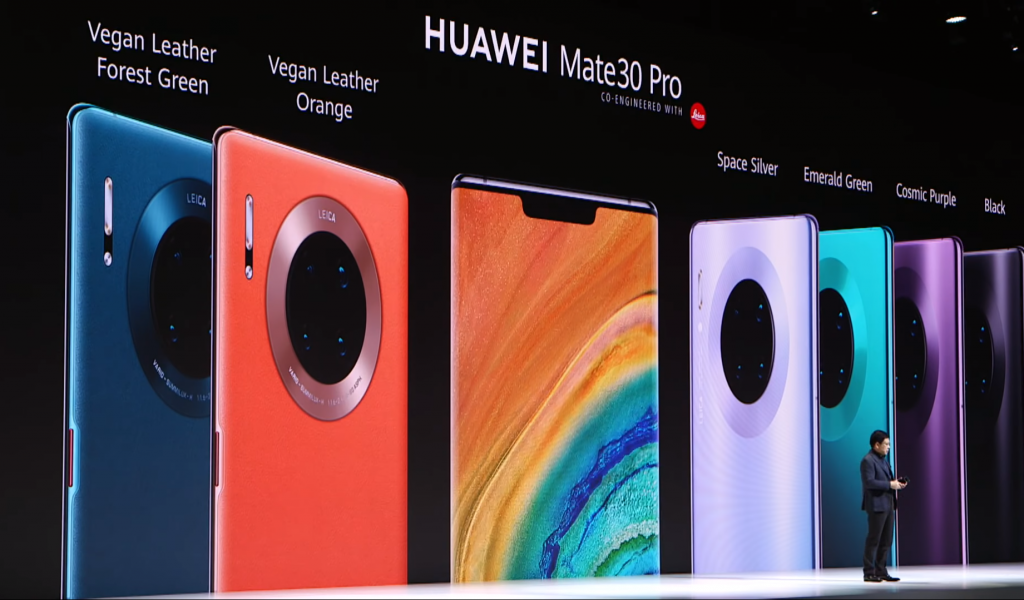
The full specifications of the Mate 30 Pro are as following:
- Kirin 990 4G/Kirin 990 5G
- 8GB of RAM
- 256GB of internal storage, expandable with nano-memory card, up to 256GB
- 6.53” Flex OLED display, with 2400*1176 pixels resolution, notch
- 18.4:9 Aspect ratio, DCI-P3 HDR
- Anti-blue light, with 25% less harmful blue light
- Cinematic colour
- 158.1×73.1×8.8, 198 grams
- Rated IP68 (Water and dust resistant)
- In-screen fingerprint sensor, facial recognition
- Front camera, 32MP (f/2.0) RGB Camera+3D Depth Sensing
- Leica SuperSensing Cine (Quad) Camera:
- 40MP (Ultra-wide cine, 18mm, f/1.8)
- 40MP (SuperSensing wide, 27mm, f/1.6, OIS)
- 8MP (Telephoto, 80mm, f/2.4, OIS)
- 3D Depth Sensing
- 4 500mAh battery, USB Type-C charger, 40W SuperCharge, 0-70% in 30 minutes
- 27W Wireless charging, supports reverse wireless charging
- EMUI10/Android 10
- Supports Huawei M-Pen
- Wi-Fi 802.11a/b/g/n/ac, 2.4/5GHz, Bluetooth 5.1, Type-C, GPS/AGPS/GLONASS/BeiDou/Galileo/QZSS, NFC, dual-SIM
- No headphone jack
- Available in 6 colours: Black, Space Silver, Cosmic Purple, Emerald Green, Vegan Leather Orange, Vegan Leather Forest Green
- The price is as follows:
- 8GB/256GB (4G): 1 099€
- 8GB/256GB (5G): 1 199€
Huawei did not specify availability, likely due to the lack of Google services, making it very difficult to sell this device in Europe.
More on this subject:
